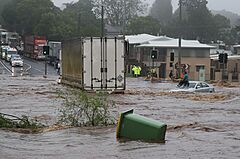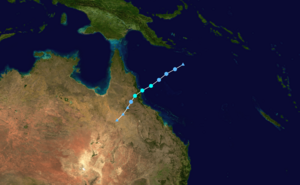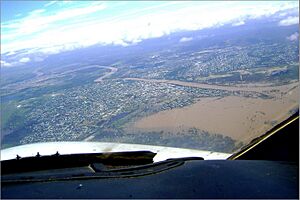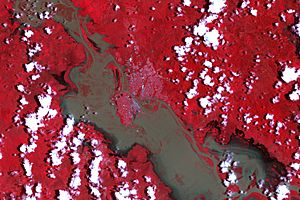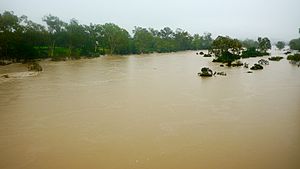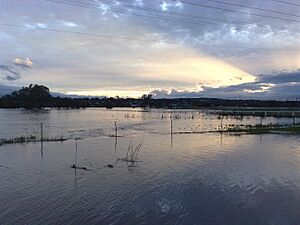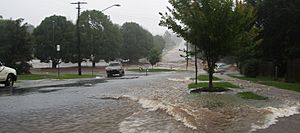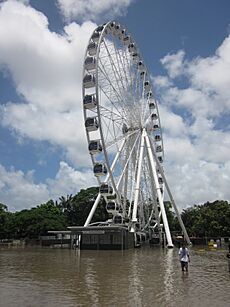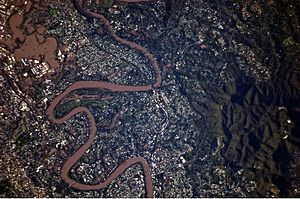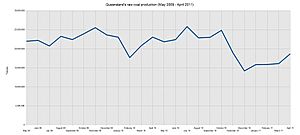2010–2011 Queensland floods facts for kids
| A woman trapped on the roof of her car awaits rescue during the Toowoomba flash flood | |
| How long: | November 2010 – January 2011 |
| Deaths: | 33 dead and 3 missing (presumed dead) |
| Damages: | A$2,389,225,876 200,000 people affected |
| Areas affected: | Much of central and southern Queensland including Brisbane, Rockhampton, Gympie, Emerald, Bundaberg, Dalby, Toowoomba, Roma, and Ipswich |
A series of floods hit Queensland, Australia, beginning in November 2010. The floods forced the evacuation of thousands of people from towns and cities. At least 90 towns and over 200,000 people were affected. Damage initially was estimated at A$1 billion before it was raised to $2.38 billion. The estimated reduction in Australia's GDP is about A$30 billion. As of March 2012, there were 33 deaths attributed to the floods, with a further three people still missing.
Three-quarters of the council areas within the state of Queensland were declared disaster zones. Communities along the Fitzroy and Burnett Rivers were particularly hard hit, while the Condamine, Ballone, and Mary Rivers recorded substantial flooding. An unexpected flash flood caused by a thunderstorm raced through Toowoomba's central business district. Rainfall from the same storm devastated communities in the Lockyer Valley. A few days later, thousands of houses in Ipswich and Brisbane were inundated as the Brisbane River rose and Wivenhoe Dam used a considerable proportion of its flood mitigation capacity. Volunteers were quick to offer assistance, and sympathy was expressed from afar. A large mobilisation of the Australian Defence Force was activated and a relief fund created. The head of the recovery taskforce was Major General Michael Slater. The Queensland Reconstruction Authority (CEO was Graeme Newton) was formed to coordinate the rebuilding program beyond the initial task force, and a Commission of Inquiry was established to investigate all matters related to the floods.
The state's coal industry was particularly hard hit. The Queensland floods were followed by the 2011 Victorian floods which saw more than fifty communities in western and central Victoria also grapple with significant flooding.
On 26 February 2021 the result of legal action, started in 2014 and won in 2019, was a partial settlement of A$440 million in compensation for thousands of flood victims, from the Queensland government and SunWater. The remaining $440 million is owed by State-owned dam operator Seqwater who is appealing the decision for which a hearing is scheduled for May. The appeal was successful.
Contents
Background
Brisbane experienced major flooding in 1893 and 1974 as the Brisbane River broke its bank and inundated low-lying areas. Towns, including St. George and Theodore, had dealt with major flooding earlier in 1996. The floods were a result of heavy rainfall caused by Tropical Cyclone Tasha that combined with a trough during the peak of a La Niña Modoki event. The 2010 La Niña Modoki weather pattern, which brings wetter conditions to eastern Australia, was the strongest since 1973. This La Niña event caused a prolonged event of heavy rainfall over Queensland river catchments. Record or near record sea surface temperatures were recorded off the Queensland coast in late 2010. December 2010 was Queensland's wettest on record, with record-high rainfall totals set in 107 locations for the month. The state's average rainfall level of 209.45 millimetres (8.25 in) exceeded the previous record of 200.1 millimetres (7.88 in) set in 1975. 2010 was also recorded as the state's wettest spring since 1900, and the Australian continent's third-wettest year. Climate scientist Kevin Trenberth thought climate change was a contributing factor in the unusually high precipitation rates. He attributed a half-degree Celsius rise in ocean temperatures around Australia to global warming (which produces extra water vapour and intensifies the monsoon). Other scientists say that it is too early to draw such a conclusion. Assertions were also made by Professor Hubert Chanson, an expert in dam and reservoir engineering with extensive firsthand knowledge of the Wivenhoe system, that mismanagement of the Wivenhoe Dam might be a contributor to the some flooding in the lower Brisbane valley. While an expert engineer, Michael O'Brien—a senior manager of an ASX-listed resources company and an outside consultant evaluating cause—agrees that "massive releases of water from Wivenhoe Dam on Tuesday, 11 January, did indeed produce most of the flooding in the Brisbane River the following afternoon, with a peak in the early hours of Thursday morning, 13 January. The dam's releases into the Brisbane River also caused the Bremer River, which winds through the city of Ipswich, and the Lockyer Creek to back up and cause much of the flooding outside Brisbane." This was corroborated by a panel of engineers hired by Insurance Council of Australia. O'Brien also found that the Wivenhoe Dam and Somerset Dam did not hold the maximum capacity they were capable of holding during the crisis period, which would have significantly alleviated flooding. Only one source, Neal Ashkanasy, who specialises in social and organisational psychology (and 35 years ago was involved in the design of Wivenhoe Dam), found fault with these results and instead finds that the dam was operated correctly throughout the time of the storm and the flood that followed, saying the "dam was run with outstanding precision."
Isolated flooding started across parts of the state in early December. On 23 December, a monsoonal trough crossed the coast from the Coral Sea, bringing torrential rain that fell in a broad swath from the Gulf of Carpentaria to the Gold Coast. The widest range of intense rainfall occurred on 27 December (with very high daily totals recorded on 25 December, near where Cyclone Tasha crossed the coast). By 30 December vast areas of Southern and Central Queensland were affected by the flood. The conditions led to a large influx of snakes in the Rockhampton area, as well as some crocodiles.
Extent
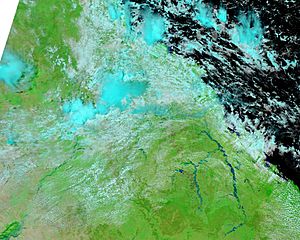
Flooding was widespread across Queensland and New South Wales from the end of December 2010 to January 2011 with several separate rain events causing rivers to rise over a lengthy period. Many places, including Condamine and Chinchilla were inundated by flood waters on multiple occasions. About 300 roads were closed, including nine major highways.
During the flooding it was reported that more than three-quarters of Queensland was affected by flooding.
Fitzroy River basin
The flooding initially forced the evacuation of 1,000 people from Theodore and other towns, described as unprecedented by the acting chief officer of the Emergency Management Queensland. The military transported residents by helicopter to an evacuation centre at Moura. The total evacuation of a Queensland town was a first for the state. Major flooding at Theodore persisted for more than two weeks.
Emerald was cut off by road on 29 December as the Nogoa River rose. By the next day, the river surpassed the 2008 flood peak level of 15.36 metres (50.4 ft). At the peak of the flooding, 80% of the town was flooded, the worst the town ever experienced. Twelve hundred Emerald residents registered as evacuees.
Rockhampton had nearly a week to prepare for an expected flood peak from the Fitzroy River, which courses through the centre of the city. The airport was closed on 1 January. A metal flood barrier was erected around the terminal to prevent flood-borne debris from causing damage to the structure. An evacuation centre was set up at the Central Queensland University. The Bruce Highway leading south out of Rockhampton was closed to traffic. The river peaked at 9.2 metres (30 ft), just short of the predicted 9.4-metre (31 ft) maximum.
The Port of Gladstone reduced its export capacity because the coal stockpiles at the port were saturated and further coal deliveries could not be made by rail. The Goonyella railway line which serves a number of coal mines in the Bowen Basin was closed for one week and shipments of grain were also delayed.
Burnett River basin
The central Burnett towns of Gayndah and Mundubbera saw major flooding on 28–29 December. The Burnett River peaked at 18.25 metres (59.9 ft) at Mundubbera—the highest river height since 1942—inundating more than 20 houses. Downstream at Gayndah, the river peaked at 16.1 metres (53 ft) with floodwaters reaching two houses. Both towns were isolated for several days and there was major disruption to the potable water supply and local agricultural production.
Bundaberg experienced severe flooding, the worst in 40 years, after the Burnett River flooded the city, although the Paradise Dam reservoir contributed to some flood mitigation. This resulted in the evacuation of 300 homes. The Bundaberg Port, a major sugar exporting facility, was closed late in December 2010 as flooding deposited silt in the port, forcing its closure. The port re-opened in early March 2011 after successful dredging operations allowed ships to berth.
Condamine/Balonne River basin
Chinchilla and Jericho were also inundated. At least 40 residents were evacuated from Chinchilla.
Flooding in Dalby was the worst since 1981. The town's water purification system was flooded, resulting in water restrictions that hampered clean-up efforts. 112,500 litres (24,700 imp gal; 29,700 US gal) of water were transported to the town of 14,000 residents. Warwick was isolated when all roads into the town were cut off.
The Condamine River reached 14.25 metres (46.8 ft) on 30 December, its highest level ever recorded. Condamine was mandatorily evacuated on 30 December.
A second rain event on 9–10 January saw floodwaters again threaten Chinchilla and Condamine with Chinchilla residents again asked to evacuate.
The Macintyre River, which forms part of the border between the Australian states of New South Wales and Queensland, began to threaten the town of Goondiwindi on 13 January. While the town is protected by an 11-metre (36 ft) levee, the local hospital and aged care home were evacuated as a precaution and an evacuation centre was established.
Mary River basin
Heavy rain in the Mary River catchment on 8–9 January 2011 led to flooding at Maryborough and Gympie. The Mary River at Maryborough was expected to initially peak at 8.5 metres (28 ft) at midday 9 January with some houses and businesses inundated by flood waters.
Toowoomba and the Lockyer Valley
The city of Toowoomba, in the Darling Downs, was hit by flash flooding after more than 160 millimetres (6.3 in) of rain fell in 36 hours to 10 January 2011; this event caused four deaths in a matter of hours. Cars were washed away (see video). Toowoomba sits on the watershed of the Great Dividing Range, some 700 metres (2,300 ft) above sea level. A three-week period where it had rained on all but three days had left the soil around Toowoomba super saturated and when a line of storms hit the city on 10 January, the resulting torrential rain rapidly ran off down gullies and streets. The central business district of the city sits in a small valley where two small water courses—East Creek and West Creek—meet to form Gowrie Creek. Unable to cope with the volume of water heading toward them, the creeks burst their banks, pushing a devastating wall of water through the city centre. This water then headed west—not towards the Lockyer Valley which was also experiencing extreme rainfall that fell on eastern facing slopes.
The surge associated with rainfall which fell on the eastern side of the range passed through the Lockyer Valley town of Withcott, where the force of the water pushed cars into shops and forced the evacuation of hundreds of people. The scene was described by an onlooker as "like Cyclone Tracy has gone through it ... If you dropped an atom bomb on it, you couldn't tell the difference." Nearby Helidon had several homes and farms flooded but did not break the main creek bank and enter the town. It was cut off from all sides by destroyed roads. Grantham was also devastated by the surge of water. Houses were left crumpled by what Premier of Queensland Anna Bligh described as an "inland tsunami". According to local media, the flood waters had reached a height of 7 or 8 metres (23 or 26 ft) by the time it struck Grantham. The peak discharge rate around Withcott and Grantham where Lockyer Creek is joined by Gatton Creek, was estimated to be 3,500 m3 second. At least 100 people were evacuated to the Helidon Community Hall. Nine people were confirmed dead, and many more feared dead among 66 reported missing. Nearby Gatton saw voluntary evacuations as the Lockyer Creek rose to a record height of 18.92 metres (62.1 ft), exceeding the previous record set in the 1893 Queensland floods.
Three people from Grantham listed as missing were officially declared dead by the Coroner on 5 June 2012.
Brisbane River catchment
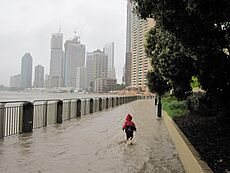
Flooding began to affect low-lying areas of Brisbane on the morning of 11 January 2011. By around 2:30 p.m. AEST, the Brisbane River broke its banks leading to evacuations in the Brisbane CBD and the suburbs of Fortitude Valley and West End. An evacuation centre was established for flood-affected residents at the RNA Showgrounds in Bowen Hills. Residents of 2,100 Brisbane streets were advised to evacuate prior to the arrival of floods, which struck the city on 12 January. Lord Mayor Campbell Newman stated than an estimated 20,000 homes would be affected when the river peaked on 14 January. He subsequently advised that the Brisbane River transport infrastructure had been "substantially destroyed".
The Brisbane River peaked on 13 January at a lower level than predicted, but still 20,000 houses in Brisbane were inundated. Some of the Brisbane suburbs worst affected by the floods were St Lucia, West End, Rocklea and Graceville. The floods damaged some of Brisbane's icons. The Brisbane Riverwalk, a floating walkway over the Brisbane River linking the inner city neighbourhoods of Fortitude Valley and New Farm, broke up, with a section forming a 300-metre (980 ft) "floating missile" that threatened the Sir Leo Hielscher Bridges. The largest part of the floating boardwalk was safely guided under the bridge by a tugboat and past other infrastructure before being safely secured. Brisbane's major Rugby league and Soccer (Association Football) venue, Suncorp Stadium, filled with water up to 2 metres (6.6 ft) deep, reaching the third or fourth row of seats.
With the flood peaking at 4.46 metres (14.6 ft) in Brisbane City, the flood level was about the tenth-highest in the city's history, several metres below the 1890 flood and the two major floods in 1893. Some unique field measurements about the peak of the floods showed very substantial sediment fluxes in the Brisbane River flood plains consistent with the murky appearance of floodwaters. The field deployment showed also some unusual features of flood flow in an urban environment linked with some local topographic effects. Parts of the western suburbs of Brisbane were cut off for three days. Resident of suburbs including Bellbowrie, Karana Downs, Moggill and Pullenvale were running low on food and other items when Moggill Road was cut, until the Australian Army was able to reach the area on 15 January with supplies.
The Bremer River at Ipswich, 30 kilometres (19 mi) west of Brisbane, reached a height of 19.4 metres (64 ft) on 12 January, inundating the central business district and at least 3,000 houses. One third of the city was reported to be underwater and over 1,100 people took shelter at evacuation centres. At Minden, on the border of Ipswich City, a four-year-old boy was swept away by floodwaters when he fell from a rescue boat. A man in his fifties died when he accidentally drove into floodwaters in the Ipswich suburb of Wulkuraka. The worst affected areas of Ipswich were the suburbs of Goodna and Gailes. The flooding led to a rare plausible claim of sharks swimming in a flooded urban area, with reports of bull sharks swimming in two streets in Goodna's center.
Further upstream, Hubners Bridge and Richards Bridge near Kilcoy were washed away. Both bridges have been rebuilt and reopened in 2012.
Elsewhere
In South East Queensland, the Wivenhoe Dam filled to a level equivalent to 191% of its supply capacity on 11 January 2011. Although the dam can hold the equivalent of 225% of its supply capacity, storage exceeding 100% is required to be progressively released through the floodgates to restore capacity to mitigate future flood events. Brisbane experienced its wettest December since 1859. Wyaralong Dam, near Beaudesert, had recently been completed and was praised for mitigating flooding in downstream Logan, having exceeded 80% of its capacity.
In North Queensland, the town of Ingham became isolated as the Herbert River peaked. Homes at Babinda and Gordonvale were flooded.
Deaths
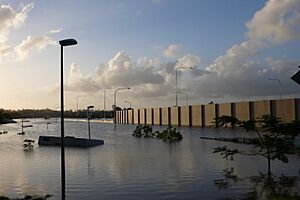
As of March 2012, 33 deaths have been attributed to the floods with 3 people still missing.
Impacts
The severe rainfall across Queensland resulted in a drop in world sea level by as much as 7 mm. The drop lasted for around 18 months and has been attributed to Australia's arheic and endorheic basins which soaked up the water previously evaporated from the oceans.
Economic
Queensland Treasurer Andrew Fraser said it was not possible to put a figure on the damage; "other than to say the damage bill is going to start with a b and not an m". The floods will cost the Australian economy at least A$10 billion. In figures released at the end of January 2011, the Insurance Council of Australia calculated that 38,460 individual claims were lodged with insurers which were worth A$1.51 billion. Nearly half of those claims were for damage to homes and more than half were made by those living in Brisbane.
The price of food across Australia will go up. The floods will cost supermarket chains tens of millions of dollars. Some communities isolated by floodwaters experienced food shortages, and a rise in the cost of fruits and vegetables was reported shortly after. Food supplies to northern Queensland were disrupted requiring groceries to be transported to Townsville by ship.
Coal railway lines were closed and numerous mine sites flooded. According to an analyst at Macquarie Group almost all the available stockpiles of coking coal in Queensland were exhausted in late January 2011 due to reduced rail capacity. About 15% of the state's annual output of coal production was lost and by late March 2011 recovery was progressing slowly. Four months after the floods the Dalrymple Bay coal terminal was operating at half its capacity as the open-cut mines in the region continued to deal with de-watering issues.
Swimming pool salt was in short supply as salt mines near Rockhampton were flooded. Thousands of litres of milk had to be dumped because it could not be transported for processing. The persistent wet conditions also caused health problems for livestock. There was severe damage to roadways in forestry plantations across wide areas of the south of the state.
Prime Minister Julia Gillard announced that the government would impose a flood levy of between $1 and $5 a week on each household, with proceeds to fund reconstruction works. This was opposed by the Liberal-National Parties which argued that the works should be funded by budget cutbacks. The Levy was approved by the Parliament in March 2011.
See also
- 1893 Brisbane flood
- 1974 Brisbane flood
- Floods in Australia
- List of disasters in Australia by death toll
- March 2010 Queensland floods
- 2013 Queensland floods
- 2010–2011 Queensland Flood and Cyclone Citation


